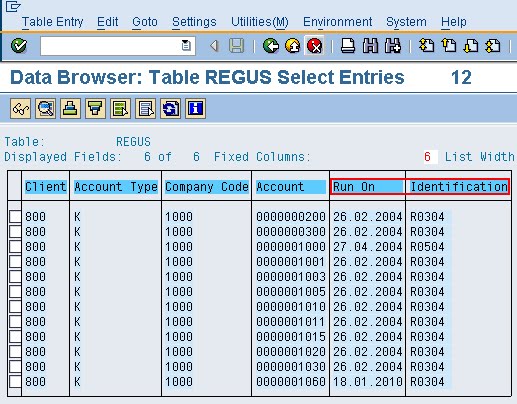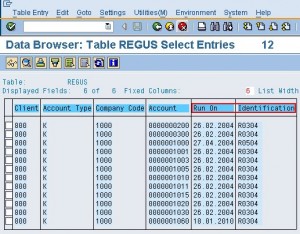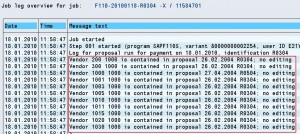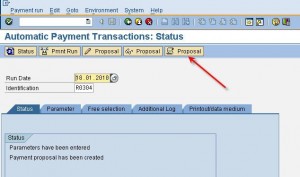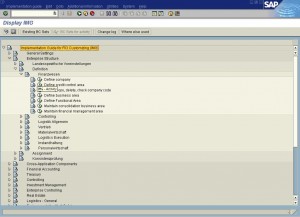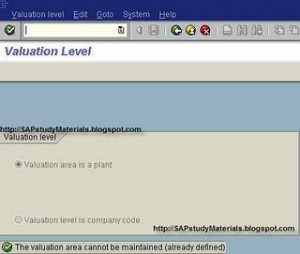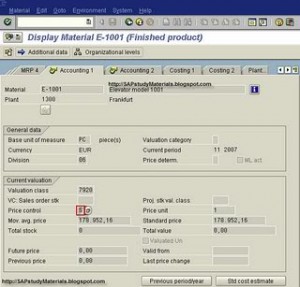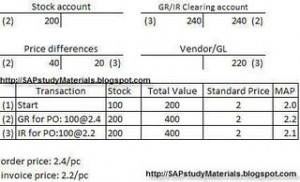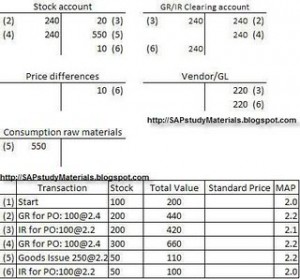Document Splitting in SAP New GL General Ledger
SAP ECC 6.0 New GL has a new functionality to create segment financial statements. With the help of document splitting one can allocate an expense line item between two segments. FI Document split and segment is covered via a ‘segment field’ which is a standard field in the
totals table in the New General Ledger FAGLFLEXT. So how does one go about document splitting.
Document splitting needs to be enabled first at the client level customizing. Once this is enabled, then document splitting can be activated / deactivated in each company code. Similarly, ‘Inheritance’ can be activated which provides the level of detail for a document split. To take an example, by activating inheritance one can create a customer invoice from a revenue line item. The business areas or segements are automatically populated in the general ledger view showing the customer and tax line items. Activation of ‘Inheritance’ is recommended with document splitting as this does not require the business to then create ‘rules’ for business processes to ensure that account assignments are projected.
Document splitting in New GL can be divided into passive split, active(rule based) split or clearing lines by document. With passive document splitting, during clearing of a document, the account assignments of the items to clear are inherited to the clearing line items. Active splitting works on the principle of defining splitting rules. Splitting rules are configured which are used by SAP to make a document split. Finally, in case of clearing lines, New GL creates clearing lines automatically to achieve a split. Document splitting is
one of the key functionalities enabled by SAP New GL to help deliver segmented financial statements.
What is credit memo processing in SAP FICO?
Credit memos in SAP are used to correct a vendor invoice. Once the invoice and the credit memo difference is posted in SAP, any open items left in the invoice, credit memo and payment can be cleared. To take an example, suppose you purchase office supplies worth $500. A user posts an invoice received from the vendor. Now suppose the user comes to know that $150 has already been paid on the invoice. A credit memo is used in such cases. In our example, the user will process a credit memo worth $150 in SAP. The difference between the invoice amount and credit memo i.e. $100 would be paid to the vendor via check.
Special Ledger – OBS2
Special Ledger can be assigned by the transaction OBS2. If a ledger is assigned using OBS2, then it is valid for all company codes. In ECC6.0 and later, the concept of special ledger is not there. The concept of non-lending ledger is there.
What is Automatic Posting?
When you post documents in SAP, there are instances where the system also adds some more line items (such as tax, cash discount, gain/loss from foreign exchange transactions, etc.) besides the ones you have entered in the document. This helps to reduce your work as the system calculates these automatically. However, you need to define accounts you want the system to automatically post to; this will ensure that no manual posting is allowed to any of these accounts.
Define a Company
Company: Smallest organizational unit for which individual financial statements can be drawn up according to the relevant commercial law. A company can consist of one or more company codes.
A company is generally used in the legal consolidation module to roll up financial statements of several Company-Codes. A company can consist of one or more Company-Codes. It is important to make the distinction that a Company is NOT the same as a Company-Code.
Company code links – What is a company code? Company code Configuration
Menu Path:
SAP Reference IMG -> Enterprise Structure -> Definition -> Financial Accounting -> Define Company
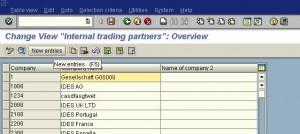
Material Valuation
Material valuation is one of the “must-know” topics for all SAP Material Management (MM) learners, especially for MM consultant, FI consultant, and FI & MM administrator in a company. In a company, the material valuation procedure must be determined together with accounting department. It determines, among other things, how a material transaction recorded in accounting journal.
The first thing that we should know in material valuation is the Valuation Area. It is the organizational level at which material is valuated. In SAP R/3 system, there are two possible organizational level at which material is valuated:
1. Plant.
When stock is valuated at plant level, we can evaluate a material in different plants at different prices. Valuation must be at this level in the following cases:
· If we want to use the application component Production Planning (PP) or Costing
· If our system is a SAP Retail system
2. Company Code.
When stock is valuated at company code level, the valuation price of a material is the same in all of a company’s plants (that is, in a company code).
SAP recommends that we set material valuation at Plant level.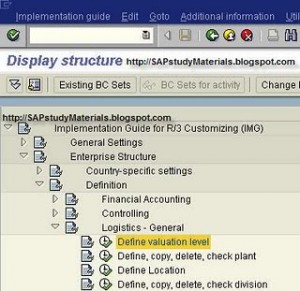
We can define the valuation level in configuration process with T-Code SPRO and will be valid for whole client. The configuration process can be seen at these screen shots:
If we’ve never defined this before, the “Valuation Level” screen will be editable, but in this example it is not editable because it has been defined before. Defining the valuation level in Configuring is a fundamental setting, and is very difficult to reverse.
The transactions in Inventory Management that can affect the valuation price of material in accounting record (depending on the type of price control) are:
· Goods Receipts.
· Goods Issues.
· Transfer Postings (for example, a stock transfer between two plants or a transfer posting from one material to another).
· Postings in Invoice Verification.
We must create the accounting data for each valuation area for all valuated materials so the above transactions can be carried out for those materials. In the accounting view of material master data, we can get an overview of the present valuation.
Valuation of goods receipts depends on the price control procedure we set in the material master record. In the R/3 System, material valuation can be carried out according to the moving average price procedure (V price) or the standard price procedure (S price).
In the standard price procedure (price control “S”), the system carries out all stock postings at a price defined in the material master. Variances are posted to price difference accounts.
In the moving average price procedure (price control “V”), the system valuates goods receipts with the purchase order price and goods issues with the current moving average price. The system automatically calculates the latter upon every goods movement by dividing the total value by the total stock quantity. Differences between the purchase order price and the invoice are posted directly to the relevant stock account if there is sufficient stock coverage.
Characteristic of Price Control “S”:
· All stock postings are made at a standard price.
· The system posts all differences from the standard price to an account “Expense/Revenue from price difference”.
· Exact values are available for cost accounting / controlling purposes (All goods issues, such as issues to a production order, are evaluated at the same standard price. This allows better analysis of the costs of production orders).
· In the accounting view, we can display differences between the delivered price and the standard price.
· We can change material prices if required (generally at the end of period). This causes the system to revaluate the total stock for a valuation area.
Posting at Standard Price.
A receipt posted to a stock account is generally posted at the standard price. Differences between the order price and the standard price are posted to an “Expenses/revenue from price differences” account (2).
Differences between the invoice price and the order price are posted to an “Expenses/revenue from price differences” account (3).
The moving average price is also recorded in the material master when the material is valuated at a standard price. It indicates the extent to which the standard price differs from the delivered price.
Characteristic of Price Control “V”.
· Receipts are evaluated at their actual price (as per purchase order, invoices,…)
· The system modifies the price in the material in the material master according to the delivered price.
· Issues are generally valuated at the current material price.
· The data used for cost accounting / controlling purposes therefore contains price fluctuations.
· Only in exceptional circumstances does the system post at a difference to the “Expenses/Revenues from price differences” account (The system makes a posting to an “Expenses/revenue from price differences” account for a material valuated at a moving average price only in the case of a debit or credit when the stock coverage in the company code is smaller than the quantity to be debited or credited, e.g.: When we reverse an invoice, the account movements made when the invoice was posted cannot always simply be reversed. For example, if there was sufficient stock coverage when we posted an invoice with a price variance for a material with moving average price, but when we reverse the invoice, there is insufficient stock coverage, the R/3 System posts the price difference in the credit memo to a price difference account, although the price variance was debited to the stock account when we posted the invoice)
· We can change material prices if required (generally at the end of period). This causes the system to revaluate the total stock for a valuation area.
Postings at Moving Average Price.
Receipts to the stock account are posted with the value Quantity x Order price. The moving average price is recalculated after every transaction and is therefore adjusted in line with delivered prices (2)/(4).
Differences between the order price and the invoice price are debited to the stock account, as the invoiced quantity is in stock (3).
The difference between the order price and the invoice price is only posted for the 50 pieces in stock. For the remaining 50 pieces that are not in stock, the difference between the order price and the invoice price is posted to an “Expenses/revenue from price differences” account (6).
Finance Terms
Client: In commercial, organizational and technical terms, a self-contained unit in an R/3 System with separate master records and its own set of tables.
Company Code: The smallest organizational unit of Financial Accounting for which a complete self-contained set of accounts can be drawn up for purposes of external reporting.
Business Area: An organizational unit of financial accounting that represents a separate area of operations or responsibilities within an organization and to which value changes recorded in Financial Accounting can be allocated.
Enterprise structure: A portrayal of an enterprise’s hierarchy. Logical enterprise structure, including the organizational units required to manage the SAP System such as plant or cost center.
Social enterprise structure, description of the way in which an enterprise is organized, in divisions or user departments. The HR application component portrays the social structure of an enterprise
fiscal year variant: A variant defining the relationship between the calendar and fiscal year. The fiscal year variant specifies the number of periods and special periods in a fiscal year and how the SAP System is to determine the assigned posting periods.
Fiscal Year: A period of usually 12 months, for which the company produces financial statements and takes inventory.
Annual displacement/Year shift: For the individual posting periods various entries may be necessary. For example, in the first six periods the fiscal year and calendar year may coincide, whereas for the remaining periods there may be a displacement of +1.
Chart of Accounts: Systematically organized list of all the G/L account master records that are required in a company codes. The COA contains the account number, the account name and control information for G/L account master record.
Financial statement version: A hierarchical positioning of G/L accounts. This positioning can be based on specific legal requirements for creating financial statements. It can also be a self-defined order.
Account group: An object that attributes that determine the creation of master records. The account group determines: The data that is relevant for the master record A number range from which numbers are selected for the master records.
Field status group: Field status groups control the additional account assignments and other fields that can be posted at the line item level for a G/L account.
Posting Key: A two-digit numerical key that determines the way line items are posted. This key determines several factors including the: Account type, Type of posting (debit or credit),Layout of entry screens .
Open item management: A stipulation that the items in an account must be used to clear other line items in the same account. Items must balance out to zero before they can be cleared. The account balance is therefore always equal to the sum of the open items.
Clearing: A procedure by which the open items belonging to one or more accounts are indicated as cleared (paid).
Reconciliation account: A G/L account, to which transactions in the subsidiary ledgers (such as in the customer, vendor or assets areas) are updated automatically.
Special G/L indicator: An indicator that identifies a special G/L transaction. Special G/L transactions include down payments and bills of exchange.
Special G/L transaction: The special transactions in accounts receivable and accounts payable that are shown separately in the general ledger and sub-ledger.
They include:
- Bills of exchange
- Down payments
- Guarantees
House Bank: A business partner that represents a bank through which you can process your own internal transactions.
Document type: A key that distinguishes the business transactions to be posted. The document type determines where the document is stored as well as the account types to be posted.
Account type: A key that specifies the accounting area to which an account belongs.
Examples of account types are:
- Asset accounts
- Customer accounts
- Vendor accounts
- G/L accounts
Dunning procedure: A pre-defined procedure specifying how customers or vendors are dunned.
For each procedure, the user defines
- Number of dunning levels
- Dunning frequency
- Amount limits
- Texts for the dunning notices
Dunning level: A numeral indicating how often an item or an account has been dunned.
Dunning key: A tool that identifies items to be dunned separately, such as items you are not sure about or items for which payment information exists.
Year-end closing: An annual balance sheet and profit and loss statement, both of which must be created in accordance with the legal requirements of the country in question.
Standard accounting principles require that the following be listed:
- All assets
- All debts, accruals, and deferrals
- All revenue and expenses
Month-end closing: The work that is performed at the end of a posting period.
Functional area: An organizational unit in Accounting that classifies the expenses of an organization by functions such as:
- Administration
- Sales and distribution
- Marketing
- Production
- Research and development
Classification takes place to meet the needs of cost-of-sales accounting.
Noted item: A special item that does not affect any account balance. When you post a noted item, a document is generated. The item can be displayed using the line item display. Certain noted items are processed by the payment program or dunning program – for example, down payment requests.
Accrual and deferral: The assignment of an organization’s receipts and expenditure to particular periods, for purposes of calculating the net income for a specific period.
A distinction is made between:
- Accruals –
An accrual is any expenditure before the closing key date that represents an expense for any period after this date.
- Deferral –
Deferred income is any receipts before the closing key date that represent revenue for any period after this date.
Statistical posting: The posting of a special G/L transaction where the offsetting entry is made to a specified clearing account automatically (for example, received guarantees of payment).
Statistical postings create statistical line items only.
Valuation area: An organizational unit in Logistics subdividing an enterprise for the purpose of uniform and complete valuation of material stocks.
Chart of depreciation: An object that contains the defined depreciation areas. It also contains the rules for the evaluation of assets that are valid in a specific country or economic area. Each company code is allocated to one chart of depreciation. Several company codes can work with the same chart of depreciation. The chart of depreciation and the chart of accounts are completely independent of one another.
Asset class: The main criterion for classifying fixed assets according to legal and management requirements.
For each asset class, control parameters and default values can be defined for depreciation calculation and other master data.
Each asset master record must be assigned to one asset class.
Special asset classes are, for example:
- Assets under construction
- Low-value assets
- Leased assets
- Financial assets
- Technical assets
Depreciation area: An area showing the valuation of a fixed asset for a particular purpose (for example, for individual financial statements, balance sheets for tax purposes, or management accounting values).
Depreciation key: A key for calculating depreciation amounts.
The depreciation key controls the following for each asset and for each depreciation area:
- Automatic calculation of planned depreciation
- Automatic calculation of interest
- Maximum percentages for manual depreciation
The depreciation key is defined by specifying:
- Calculation methods for ordinary and special depreciation, for interest and for the cutoff value
- Various control parameters
Period control method: A system object that controls what assumptions the system makes when revaluating asset transactions that are posted partway through a period.
Using the period control method, for example, you can instruct the system only to start revaluating asset acquisitions in the first full month after their acquisition.
The period control method allows different sets of rules for different types of asset transactions, for example, acquisitions and transfers.
Depreciation base: The base value for calculating periodic depreciation.
The following base values are possible, for example:
- Acquisition and production costs
- Net book value
- Replacement value
Controlling Terms
Controlling Area: An organizational unit within a company, used to represent a closed system for cost accounting purposes. A controlling area may include single or multiple company codes that may use different currencies. These company codes must use the same operative chart of accounts.
Cost center std Hierarchy : Indicated hierarchy of cost center groups in which all cost centers in a controlling area are gathered together.
Cost element : A cost element classifies the organization’s valuated consumption of production factors within a controlling area. A cost element corresponds to a cost-relevant item in the chart of accounts.
Primary cost element: A cost element whose costs originate outside of CO and accrual costs that are used only for controlling purposes
Secondary cost element: A cost element that is used to allocate costs for internal activities. Secondary cost elements do not correspond to any G/L account in Financial Accounting. They are used only in Controlling and consequently cannot be defined in FI as an account.
Cost element category: The classification of cost elements according to their usage or origin.
Examples of cost element categories are:
- Material cost elements
- Settlement cost elements for orders
Cost elements for allocating internal activities
Reconciliation ledger: A ledger used for summarized display of values that appear in more detailed form in the transaction data.
The reconciliation ledger has the following functions:
- Reconciles Controlling with Financial Accounting: The reconciliation ledger provides reports for monitoring the reconciliation of Controlling with Financial Accounting by account.
- It can identify and display value flows in Controlling across company code, functional area, or business area boundaries
- Provides an overview of all costs incurred : Reconciliation ledger reports provide an overview of the costs and are therefore a useful starting point for cost analysis. For example, an item in the profit and loss statement from the Financial Information System (FIS) can be examined in the reconciliation ledger reports with respect to the relevant costs. For more detailed analysis, reports from other components within Controlling can be accessed from the reconciliation ledger reports.
Cost Center: An organizational unit within a controlling area that represents a defined location of cost incurrence.
The definition can be based on:
- Functional requirements
- Allocation criteria
- Physical location
- Responsibility for costs
Cost center category: An attribute that determines the type of cost center.
Example
- F – Production cost center
- H – Service cost center
Controlling area: An organizational unit within a company, used to represent a closed system for cost accounting purposes.
A controlling area may include single or multiple company codes that may use different currencies. These company codes must use the same operative chart of accounts.
All internal allocations refer exclusively to objects in the same controlling area.
Statistical key figure: The statistical values describing:
- Cost centers
- Orders
- Business processes
- Profit centers
There are the following types of statistical key figures:
- Fixed value – Fixed values are carried forward from the current posting period to all subsequent periods.
- Total value –
Totals values are posted in the current posting period only
Activity type: A unit in a controlling area that classifies the activities performed in a cost center.
Example
Activity types in production cost centers are machine hours or finished units.
Allocation cost element : A cost element used to illustrate activity allocation in terms of values. The allocation cost element is a secondary cost element , under which the activity type or business process is allocated.
The allocation cost element is the central characteristic used in all CO postings. It is therefore also an important criterion for reporting – for example, many reports are structured according to the posted cost elements.
Assessment cost element: A secondary cost element for costs that are assessed between Controlling objects.
Reposting: A posting aid in which primary costs are posted to a receiver object under the original cost element (the cost element of the sender object).
Repostings are used to rectify incorrect postings. The following methods are available:
- Transaction-based reposting –
Each posting is made in real time during the current period.
- Periodic reposting –
Produces the same results as transaction-based reposting. The costs being transferred are collected on a clearing cost center and then transferred at the end of the period according to allocation bases defined by the user.
Distribution: A business transaction that allocates primary costs.
- The original cost element is retained in the receiver cost center.
- Information about the sender and the receiver is documented in the Controlling document.
Assessment: A method of internal cost allocation by which you allocate the costs of a sender cost center to receiver CO objects (such as orders and other cost centers) using an assessment cost element.
The SAP System supports the following:
- Hierarchical method (where the user determines the assessment sequence)
- Iterative method (where the SAP System determines the sequence of assessment using iteration).
Example:
The costs from the cafeteria cost center could be assessed based on the statistical key figure "employee", which was set up on the receiver cost center.
Receiver cost center I has 10 employees, receiver cost center II has 90. The costs of the cafeteria cost center would be transferred (assessed) to receiver cost center I (10%) and receiver cost center II (90%). The credit on the cafeteria cost center and the debit of the two receiver cost centers are posted using an assessment cost element. Depending on the system setting, the total costs or some of the costs for the cafeteria cost center would be
Internal order: An instrument used to monitor costs and, in some instances, the revenues of an organization.
Internal orders can be used for the following purposes:
- Monitoring the costs of short-term jobs
- Monitoring the costs and revenues of a specific service
- Ongoing cost control
Internal orders are divided into the following categories:
- Overhead orders – For short-term monitoring of the indirect costs arising from jobs. They can also be used for continuous monitoring of subareas of indirect costs. Overhead orders can collect plan and actual costs independently of organizational cost center structures and business processes, enabling continuous cost control in the enterprise.
- Investment orders – Monitor investment costs that can be capitalized and settled to fixed assets.
- Accrual orders – Monitor period-based accrual between expenses posted in Financial Accounting and accrual costs in Controlling.
- Orders with revenues – Monitor the costs and revenues arising from activities for partners outside the organization, or from activities not belonging to the core business of the organization.
Order type: A tool that categorizes orders according to purpose.
The order type contains information which is necessary for managing orders. Order types are client-specific. The same order type can be used in all controlling areas in one client.
Example
- Production orders
- Maintenance orders
- Capital investment orders
- Marketing orders
Cost of sales accounting: A type of profit and loss statement that matches the sales revenues to the costs or expenses involved in making the revenue (cost of sales).
The expenses are listed in functional areas such as:
- Manufacturing
- Management
- Sales and distribution
- Research and development
Cost of sales accounting displays how the costs were incurred. It represents the economic outflow of resources.
